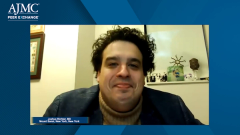
Future Directions in MM
An expert looks to the future directions in multiple myeloma and discusses upcoming advances in the field.
Joshua Richter, MD: Although daratumumab has been in our armamentarium for about 5 to 6 years now, it’s only within the last year that we’ve had of Darzalex Faspro, the subcutaneous version of daratumumab. There are many advantages of the subcutaneous version. One is that it’s a flat dose, so there’s no more concern about weight-based dosing strategies. The infusion time is obviously way shorter, taking infusion times from hours down to only a few minutes. Actually, in clinical practice, the infusion-related reaction rate is lower with the subcutaneous version than with the intravenous [IV] version.
We’ve seen a number of studies now published and presented at ASH [the American Society of Hematology annual meeting 2020] looking at giving Darzalex Faspro, the subcutaneous version, with a variety of our backbone myeloma therapies. These data continue to show essentially equivalent efficacy across the board no matter which backbone regimen you choose to use. And yes, there are lower rates of IRRs, infusion-related reactions, with the subcutaneous version, and of course, great reductions in chair time.
Overall, this has let us, in the clinic, transfer almost all of our patients from the intravenous version to the subcutaneous version. In fact, the only patients we continue to care for routinely on IV daratumumab are those who have already been on it for so long, they simply don’t want to switch, like when you’re prescribed a medication and all of a sudden the pharmacy wants to give you a generic. Even though we’ve explained the risks and benefits, some patients who have done very well on this drug for years continue to want to maintain on the IV doses. However, overall, the majority of our patients have switched over to the subcutaneous administration, based on studies such as COLUMBA [NCT03277105] and PLEIADES [NCT03412565].
The 2020 ASH meeting was a combination of reinforcements of data we know to likely be true but also a peek into the near future. Some of the studies, like APOLLO [NCT03180736] comparing daratumumab, pomalidomide, dexamethasone versus pomalidomide, dexamethasone, has shown us that triplets are better than the doublets, enforcing that data in the clinic. What this really means is that more and more patients are receiving 3-drug regimens at the bedside, both in the upfront setting and in the relapsed setting. I see triplets continuing to have a major impact on the day-to-day care of myeloma patients, both up front and the relapsed setting.
Some of the most exciting stuff at ASH was looking at the bifunctional antibodies. In my mind, the bifunctional antibodies, or BiTEs, sometimes called bispecific T-cell engagers, come in 2 varieties. One is the BCMA-targeted ones and then the non-BCMA–targeted ones. BCMA, or B-cell maturation antigen, is a really exciting target. It’s a target for the recently approved belantamab mafodotin, which is an antibody-drug conjugate, and a target for the upcoming likely approval of the CAR [chimeric antigen receptor] T cell, bb2121 or ide-cel [idecabtagene vicleucel]. As a bifunctional antibody, it offers this aggressive and very efficacious immunotherapy approach without some of the potential pitfalls of CAR T in an off-the-shelf product. The data presented for teclistamab, a BCMA bifunctional antibody, is really exciting, and I’m hoping to see that in the coming years reach into the clinic. However, we know that ultimately patients progress beyond BCMA-based therapies.
There were 2 specific non-BCMA–based BiTEs presented at ASH. One of them was talquetamab, presented by Ajai Chari, MD. This is a GPRC5D-based targeted bifunctional, which has shown extremely efficacious numbers in the heavily relapsed patient. The other was cevostamab. This is an FcRH5/CD3 bifunctional antibody, and this was presented by Adam Cohen, MD. Again, it is very efficacious in a heavily pretreated group of patients.
What these therapies give us promise for is a look beyond the BCMA standard, which is likely to be one of the main approaches in managing relapsed/refractory myeloma in the coming years. I’m really excited to see that not only do we have the next step, but we have the next step after that.
Newsletter
Stay ahead of policy, cost, and value—subscribe to AJMC for expert insights at the intersection of clinical care and health economics.

























































